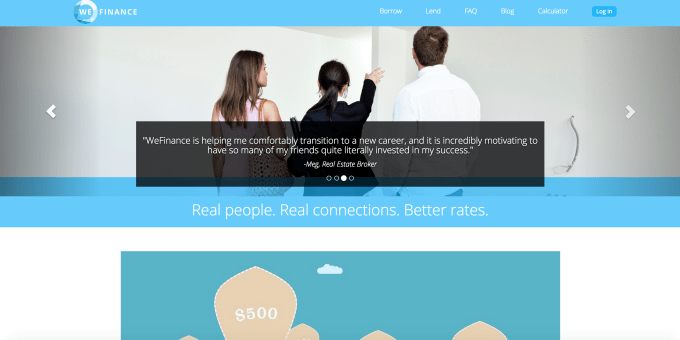WeFinance, launching today, is the latest startup to use a combination of technology and crowdfunding in order to offer borrowers lower interest rates on loans, while reducing lenders’ risk. The new peer-to-peer lending platform operates something like a Kickstarter for personal loans – largely those in the range of $10,000 to $20,000, and many of which are being used to help borrowers fund their educational expenses, including tuitions, bootcamps, financial support during unpaid internships, and more.
Founded in early 2014, the idea for the site comes from co-founder and CEO Eric Mayefsky, who previously spent three-and-a-half years at Facebook as a product manager focused on ads optimization, infrastructure and stability. He explains that, while at the company, he began to loan his friends money directly on good terms, in order to save them from the otherwise “exorbitant rates” they would have to pay on that debt.
The problem, in many cases, was that the things that made them low risk didn’t reflect on their credit scores, he explains.
“They had very little credit history,” Mayefsky says. “They had good jobs in their past or they had good jobs lined up. In my perspective, they were very low risk.”
Those loans turned out to be a win-win for both the borrower and the lender, with access to better terms on the borrowers’ side and the loan was a more productive way to put the money into use, rather than having it sit in a savings account.

Mayefsky’s experience eventually prompted the idea to build a site to formalize this process.
On WeFinance, which is also co-founded by Willy Chu, previously of Credit Karma and Kiva.org, borrowers write a brief loan application, and link to their Facebook account to verify their identity. They’re also encouraged to link to their LinkedIn too, so lenders can view their educational background and work history. The site then vets their application, offering them feedback on what to change, and if approved, it goes live. Dwolla, meanwhile, is used for the payments and WeFinance covers the fees associated with that.
But what makes WeFinance different is that borrowers are more in control of the experience. They set the upper and lower limits for their loan requests and the terms they’re willing to pay. Four percent is the most common interest rate on WeFinance’s loans, which is less than many alternatives, and certainly lower than credit cards.
In addition, the idea with WeFinance is that the borrowers aren’t meant to immediately rely on an anonymous crowd of lenders to support them, but rather they first rally support from their own network of family and friends instead.
After those close to them make their initial pledges, their loan then looks more attractive to other potential lenders who can lean on the “social proof” of the earlier commitments to help decide which options to fund.
As noted above, most of the loans to date have been in the $10,000-$20,000 range, though on the low end, they can be $1,000 and up.
The company ran a small test batch this summer, and found that the service was often being used for funding educational expenses among young adults.
“Traditional credit metrics don’t work that well for people at that stage in their life,” notes Mayefsky. But he adds the site has also helped those who are out of school, too, and undergoing a transition – like switching careers, or taking time off to have a child, for example.
WeFinance is very hands-on with the support it offers borrowers – reading applications, making suggestions on terms, and even organizing groups of similar borrowers (e.g. those looking to fund a code boot camp, those attending the same school, etc.) into “batches.” By going live on the site at the same time as others, those borrowers could benefit from network effects, Mayefsky explains.
Currently, WeFinance is not charging fees of any kind while it focuses on growth, but in the future it may either partner with banks or other companies to lend the rest of the amount when a loan is only partially funded, or it may choose to become a source of capital itself.
The San Francisco-based startup is still bootstrapping, but will raise a seed round later this year.
